If you want dramatic, fluffy pink flowers in your perennial garden, peonies may be just the right fit. These stunning blossoms smell as delightful as they look, thrive on sunlight, are easy to maintain, and can live for decades in a wide range of climate zones.
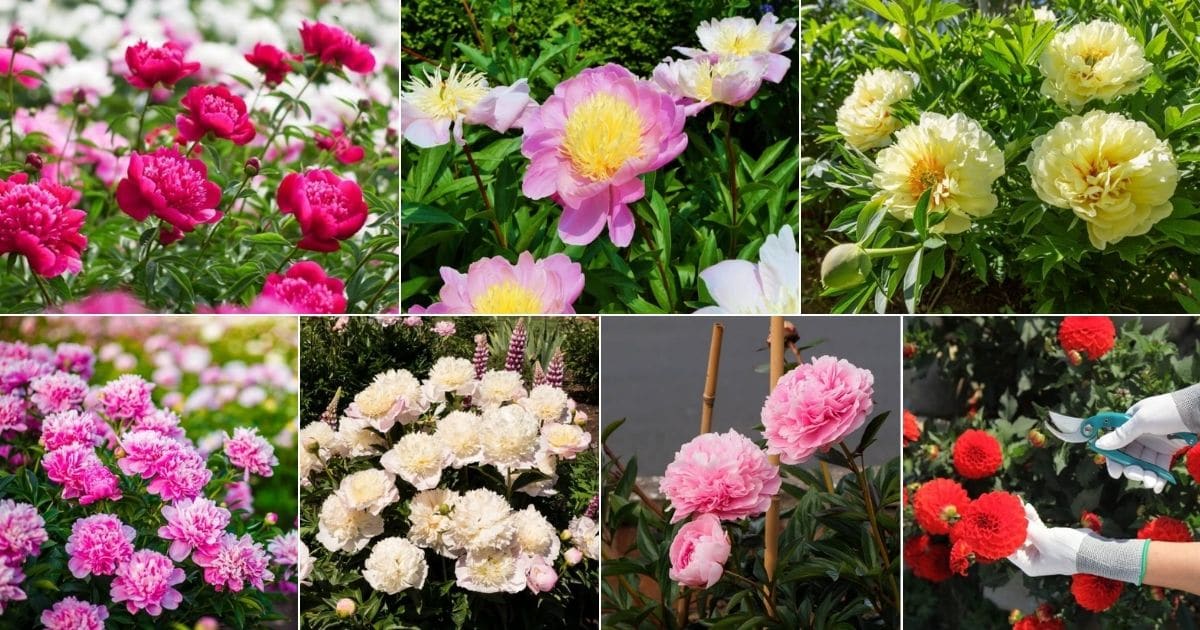
In this guide, you will learn all about these beautiful blooms. We will teach you about ideal planting conditions, steps for growing peonies, required maintenance, different varieties of peonies, and more. Let’s begin by going over peony basics.
Jump to:
- What Are Peonies?
- Herbaceous vs. Tree Peonies
- Peony Basics
- Why Grow Peonies?
- Recommended Peony Varieties
- Where Do Peonies Grow?
- When Do Peonies Bloom?
- How Long Do Peonies Bloom?
- When to Plant Peonies
- How to Plant Peonies
- Ideal Growing Conditions for Peonies
- How to Plant Peony Tubers in Your Garden Beds
- Can You Grow Peonies in Containers?
- How to Care for Peonies
- How to Transplant Peonies
- Recommended Companion Plants for Peonies
- Frequently Asked Questions About Growing Peonies
- Where to Buy Peonies
What Are Peonies?
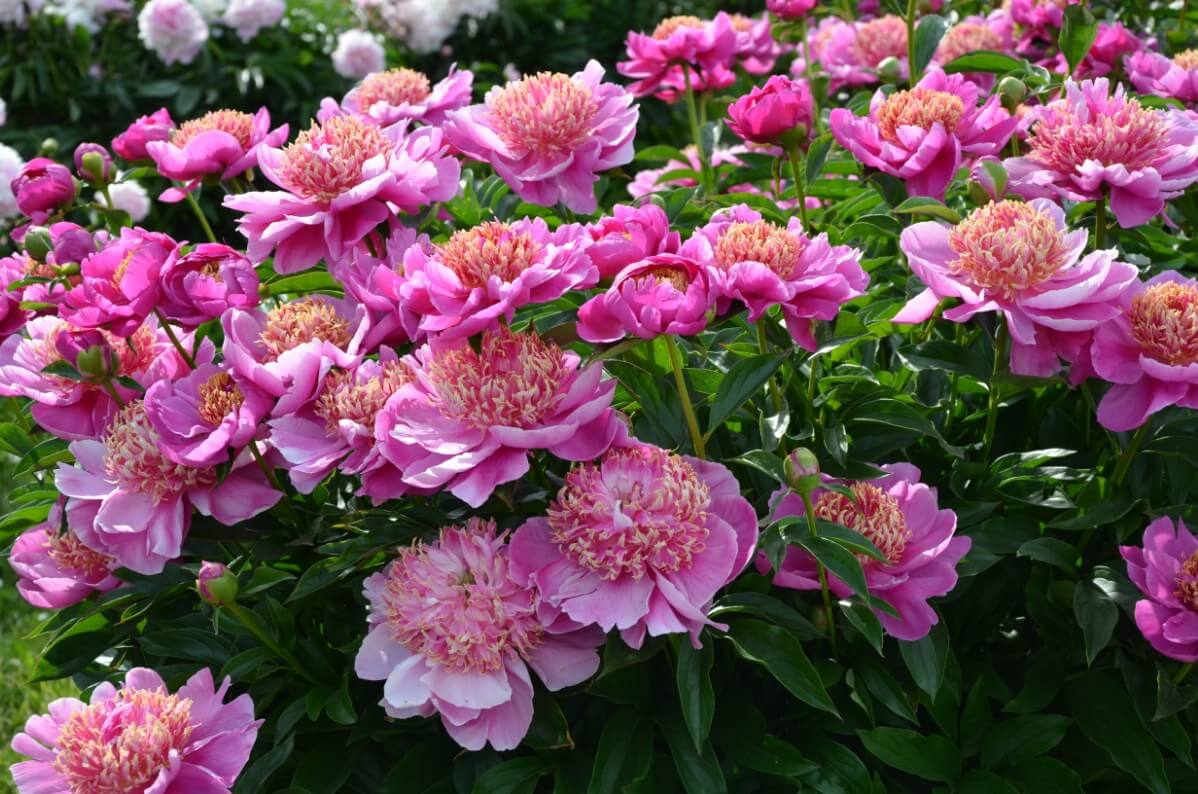
Peonies, also sometimes spelled “paeonies,” belong to the genus Paeonia in the family Paeoniaceae. There are somewhere between 25 to 40 different species of peonies—the exact number seems to depend on whom you ask, even in the scientific community. The number given most frequently is 33.
Herbaceous vs. Tree Peonies
There are two broad categories of peony plants: herbaceous peonies and tree peonies.
What to Know About Herbaceous Peonies
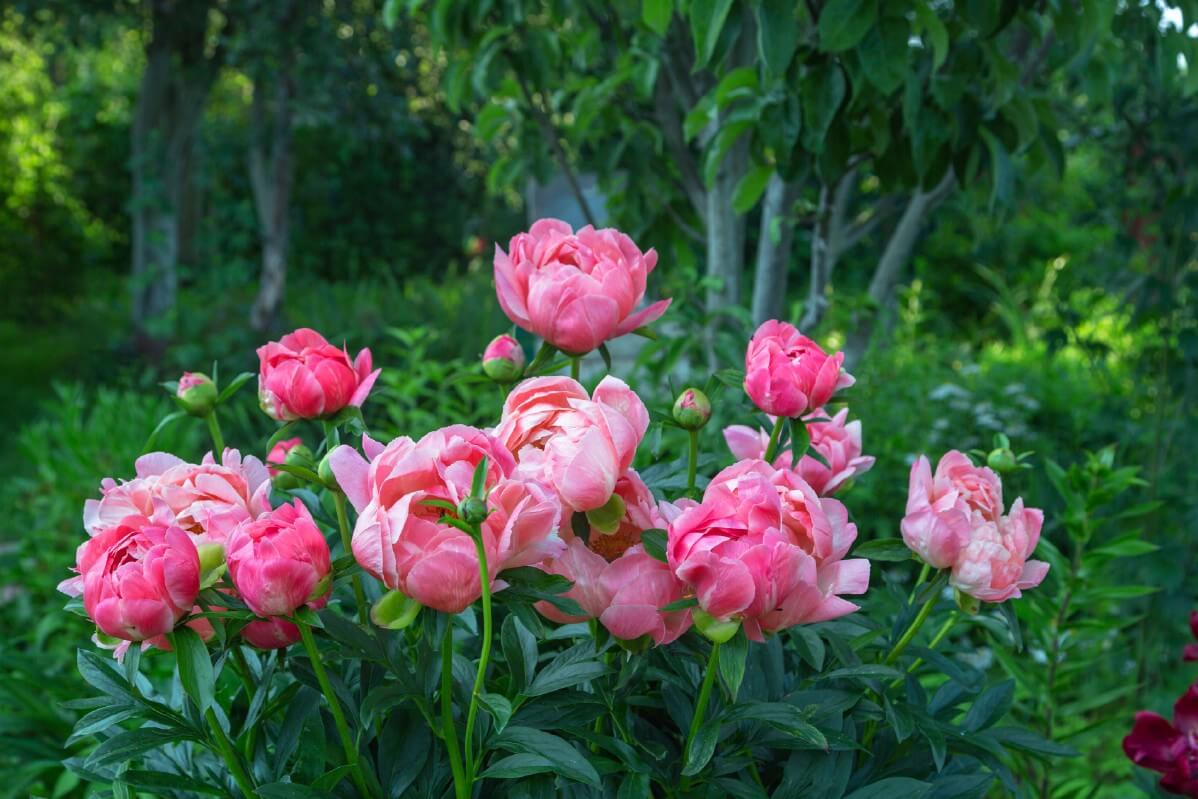
Usually when we talk about peonies, we are discussing the herbaceous type. You can plant them in zones 3-8. They will reach around 2-3 feet tall, and will blossom starting in late spring and running through early summer. The blooms last 7-10 days.
Because of their short bloom time, a lot of people plant peonies as much for their leaves as for their flowers. Their leaves are pretty and can add a lot more green to your garden for the entirety of the growing season.
What to Know About Tree Peonies
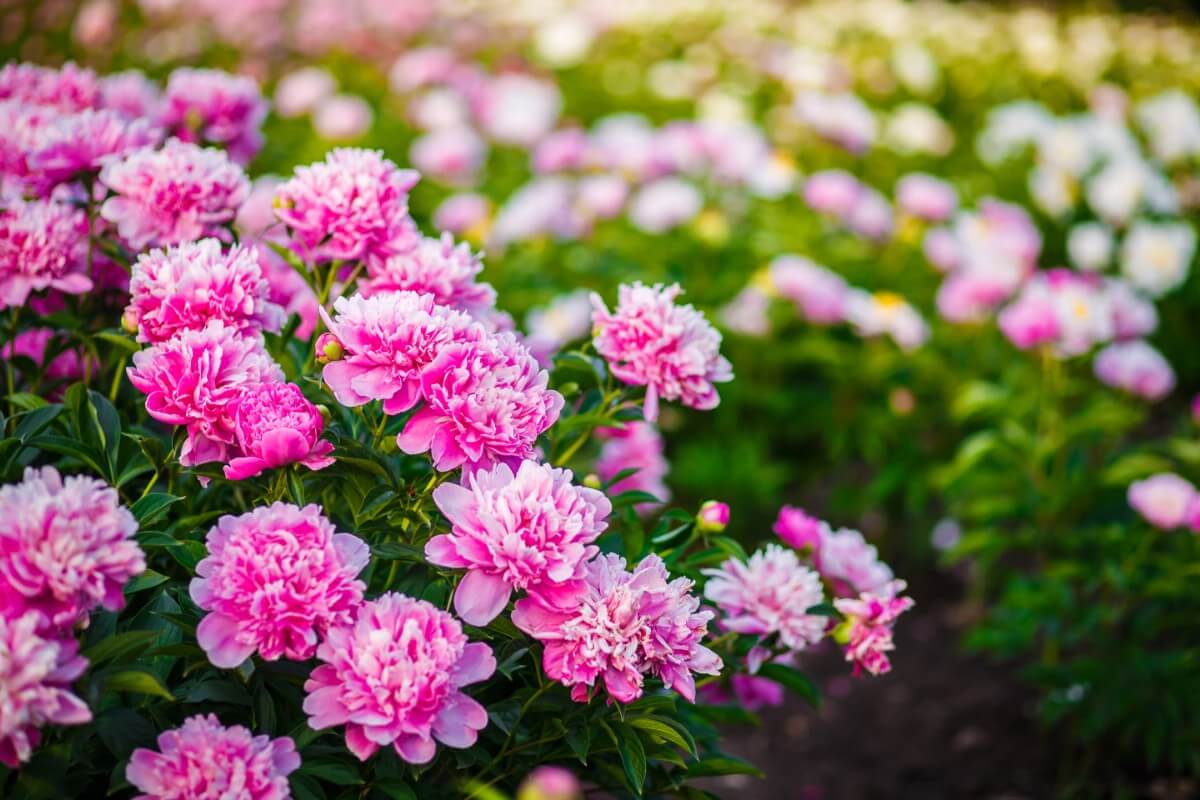
Along with herbaceous peonies, you can also try planting tree peonies. These grow best in zones 4-9, and can reach 3-7 feet tall. You should not have to stake them.
If you want later blooms than you get with the herbaceous types of peonies, tree peonies might be a good fit for you. The blossoms are some of the largest peony flowers you will find.
As with herbaceous peonies, tree peonies feature lovely leaves which also help to beautify a garden.
A Third Category: Intersectional Peonies
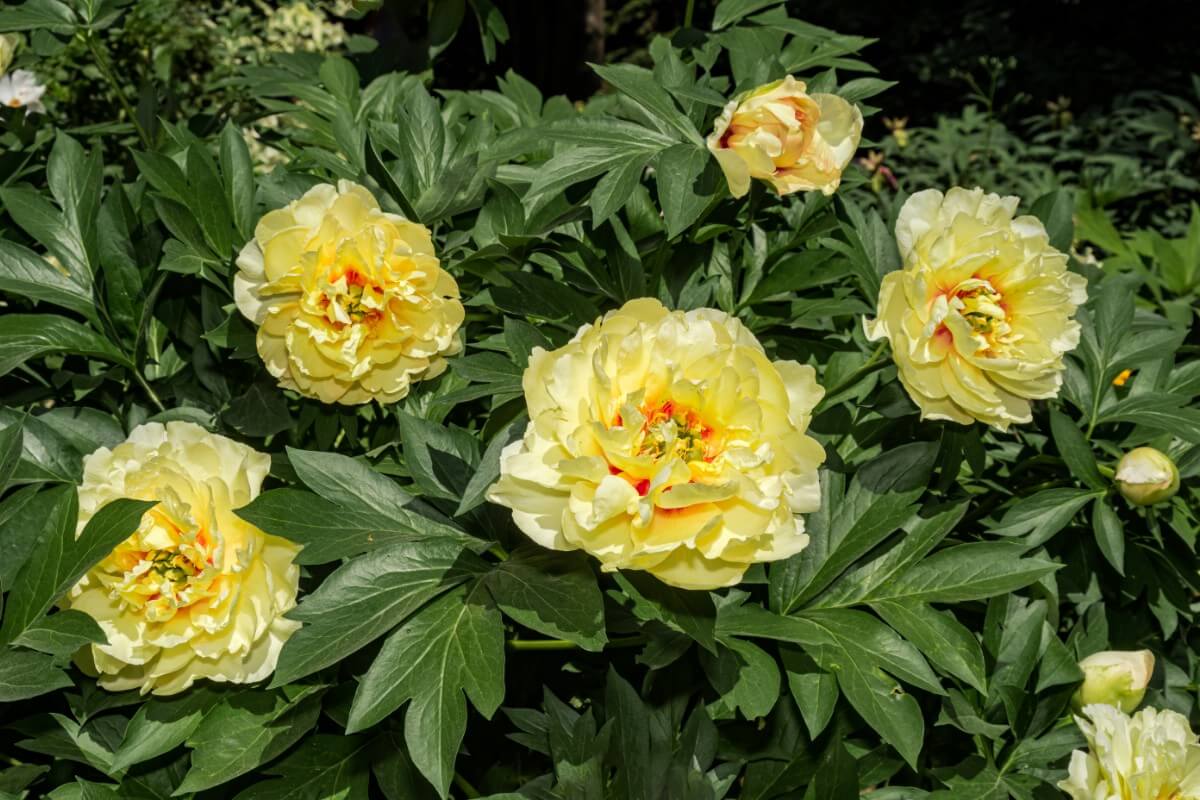
Finally, there is a third category of peony plants called “intersectional peonies,” or “Itoh hybrids.”
Just as you might guess, this is what you get when you cross herbaceous and tree peonies.
They get to be around 2.5 feet tall, and are around 3 feet wide. Their compact size is one of the attributes that makes them popular. Another is the huge number of blossoms they can produce.
Also, while many peony flowers are pinkish, these hybrids produce yellow flowers. So, they can add more variety to your color palette.
These plants also are the latest bloomers out of all of the types of peonies.
You might want to consider planting herbaceous, tree, and hybrid peonies, as you will then get the longest duration of total bloom time. Your tree peonies will bloom first and your hybrid peonies will blossom last.
Peony Basics

Zones: 3-8 (herbaceous), or 4-9 (tree)
Blooming season: Spring-summer
Expected height: 2-7 feet (depending on whether you plant herbaceous peonies or tree peonies)
Soil: Moist, well-drained, rich soil
Sun: Full or partial
Why Grow Peonies?
Now that you know the basics about peonies, let’s go over a few of the benefits of peonies.
Depending on the types of peonies you plant, they can fulfill multiple roles in your garden. For example, you can plant a single tree peony as a focal point, or you could plant a border of intersectional peonies along a walkway.
Peonies can live for a really long time! It is not unusual for a peony plant to survive for half a century. So, the peonies you plant today may be there with you for the rest of your life. And if you are passing down your home to your children, it might even be possible you will be passing your peonies down to them as well.
This garden favorite can produce an impressive bloom size. There are even some cultivars that can produce blossoms that extend up to 8 or even 10 inches across. So, even though peony flowers may not last long each year, they will make a spectacular display while they are blooming.
Peonies have a lovely scent which will add even more enjoyment to your garden when they are blossoming.
The leaves of peonies are beautiful as well, and are lovely to enjoy even without the blossoms through the spring, summer and fall.
There are many beautiful cultivars to consider. As you will see in the next section, there are so many varieties of peonies that can add charm and elegance to your garden. You will want to select them not only for their appearances, but also their bloom times. That is the trick to enjoying peonies for weeks on end each year.
Peonies can survive through harsh winters. These plants are reasonably hardy in a wide range of climate zones.
A variety of colors are available. While flower colors for peonies typically are in the pink range, these gorgeous blooms do come in other colors as well.
You can plant peonies in your garden beds or try potted peonies on your deck or patio. They are convenient to grow either way!
Recommended Peony Varieties
Now that you know some of the reasons you might want to plant peonies, let’s take a look at some types of peony you can consider for your garden.
Prairie Moon: Looking for a white peony to plant? This variety features white petals surrounding a yellow middle, creating a beautiful contrast with the green leaves. Typically, it blooms in June.
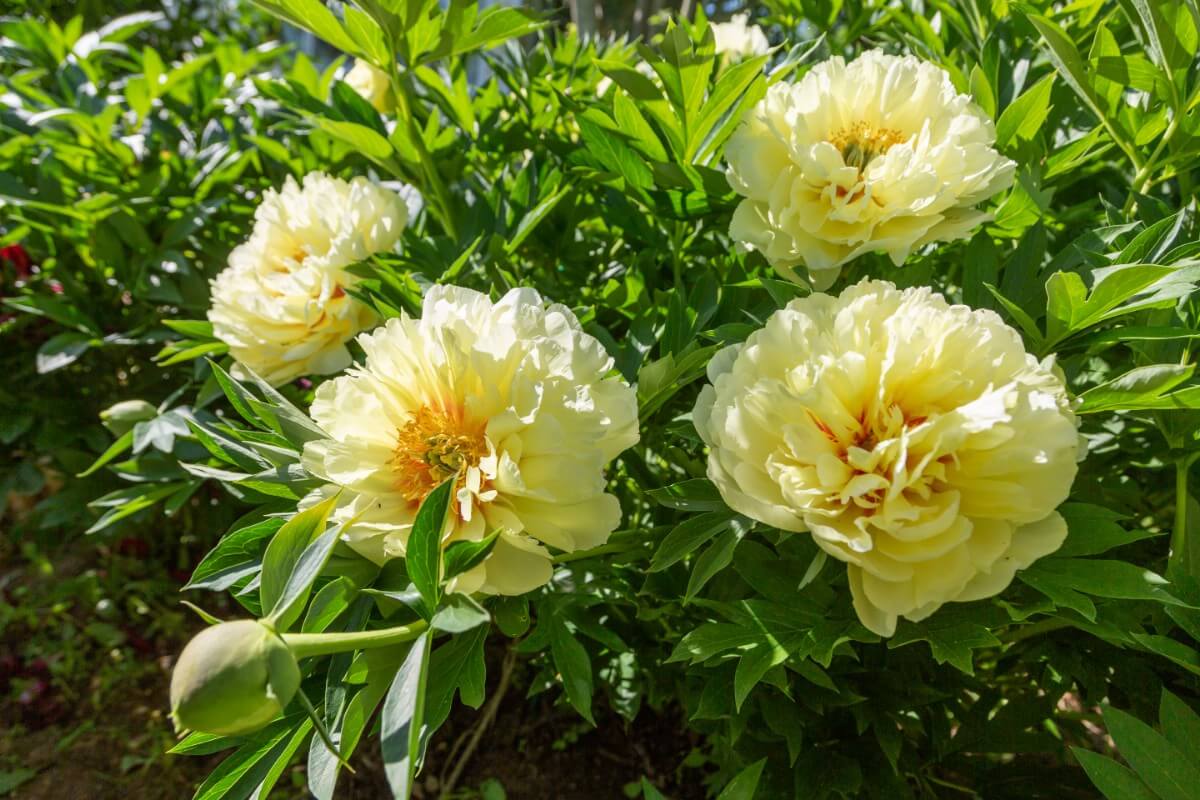
Bartzella: If you are in search of a beautiful hybrid cultivar to plant, you can consider the Bartzella variety of peony. Yellow flowers open in late spring, and the height of this plant can reach up to 3 feet tall. The fragrance of the blooms has been described as “spicy.” As the stems are pretty durable, they may hold up well in harsher climates.
Cora Louise: Another interesting hybrid cultivar to consider is the Cora Louise. If you are looking for a cultivar that will open a whole lot of flowers, this one is worth considering as a single plant can offer up to 50 blooms. You will see them appear late in springtime. The outer petals are white, and the inner ones feature pink around yellow middles.
Blaze: Another striking demonstration of the range of colors for peonies is the “blaze” cultivar, so named for the fiery deep red hue of the petals. Like many other peonies, these ones have yellow centers.
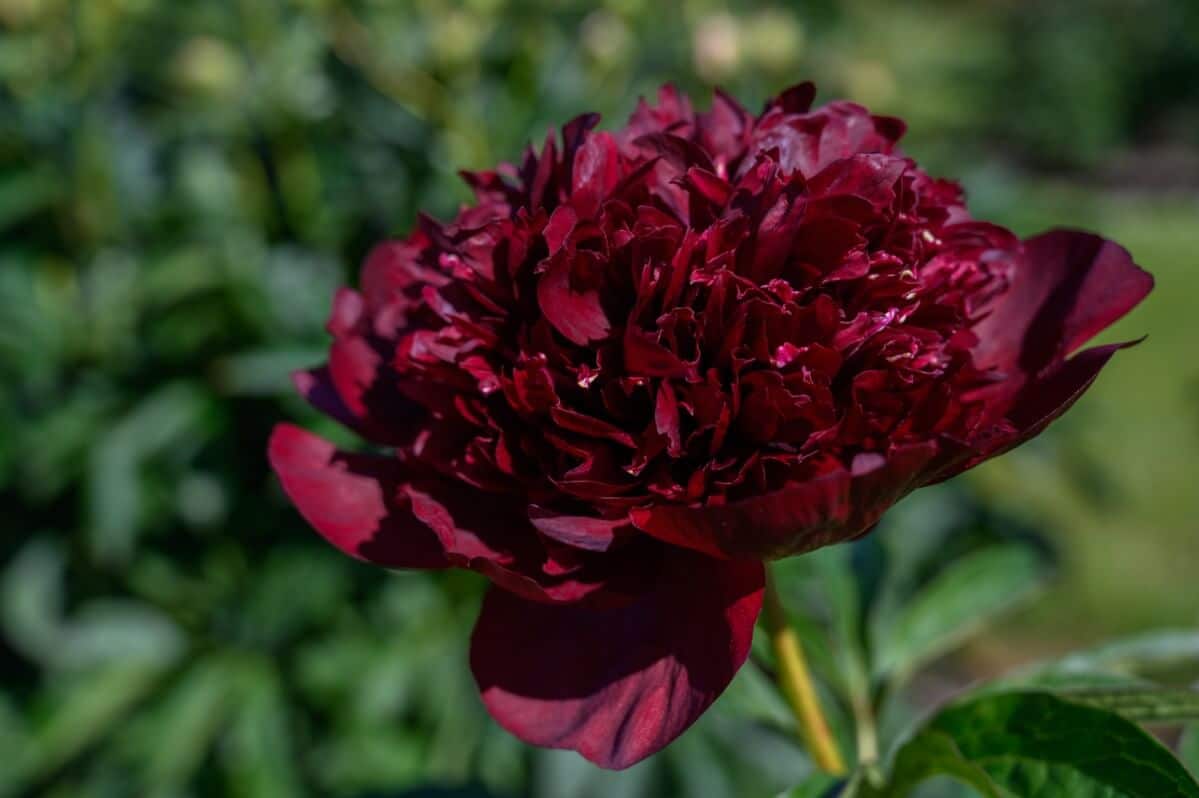
Chocolate Soldier: It is hard to say what is more eye-catching about Chocolate Soldier peonies—their deep red petals, or the distinctive cup-like formations of those petals. The yellow centers stand out vividly.
Dinner Plate: If an astonishing flower size is what you are in the market for, you need search no further than the “Dinner Plate” variety of peonies. Just as the name implies, the open pink blossoms are the size of dinner plates! To get more specific, their diameters are around 7-8”. Crazy, right?
Nippon Beauty: One of the most unique-looking peonies is the “Nippon Beauty.’ The outer petals are red, while the small, thin inner petals are a combination of red and cream, arranged in a ball formation.
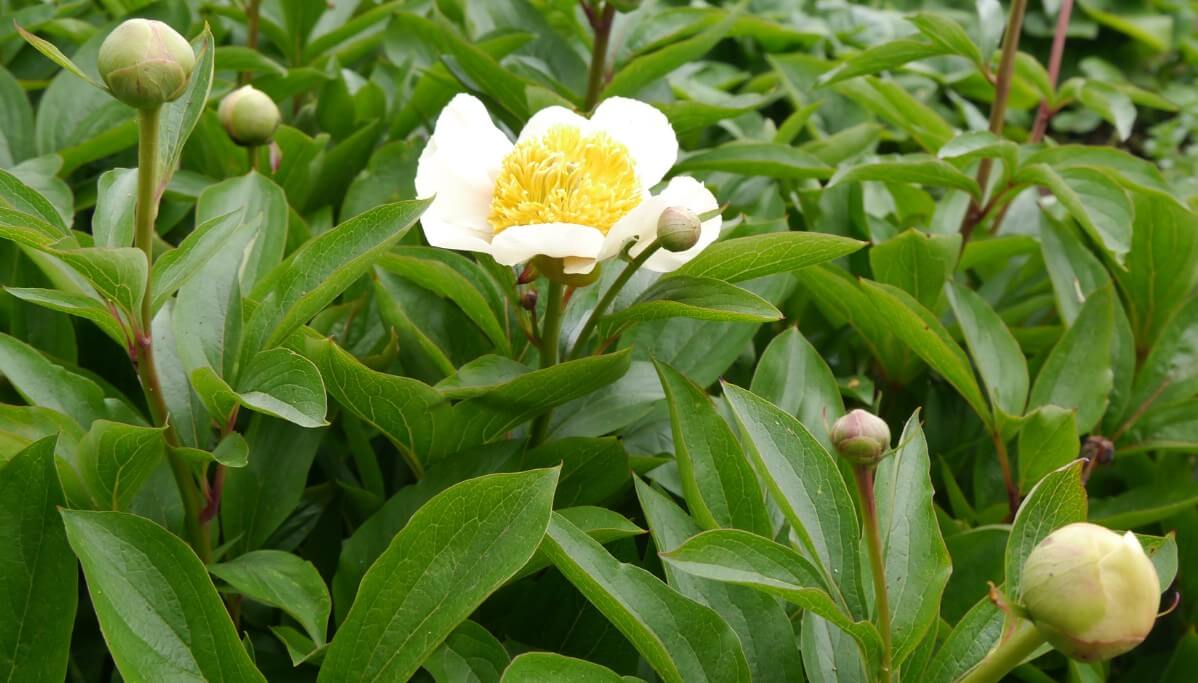
Claire de Lune: If you want peonies with really large yellow centers, the “Claire De Lune” variety is worth looking into. The petals are large and are a creamy yellow color that is close to white.
Buckeye Belle: Another option for deep red flowers is this cultivar that features contrasting yellow in the middle.
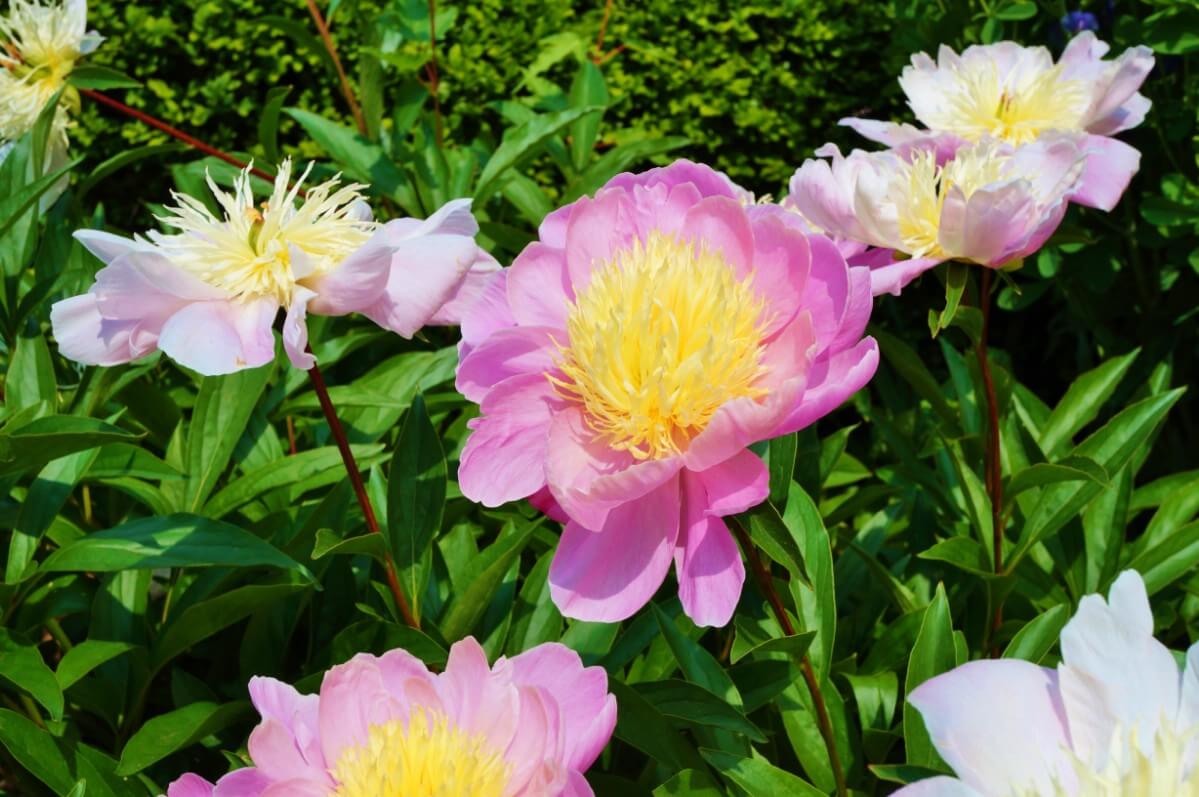
Raspberry Sundae: The name of this cultivar alludes to its petals, which are a combination of cream and pink. Together, they have a frothy appearance that is also befitting the name.
Madame Emile Debatene. A particularly stunning cultivar that is sure to get a lot of compliments from guests to your garden is the “Madame Emile Debatene.” The double pink variety features large, flat petals around the outside, and tufted, dense petals in the middle.
La Lorraine: For an ethereal effect, consider the “La Lorraine” cultivar of peony. Reaching up to 3 feet tall, this peony features creamy petals that transition to a soft, barely detectable pink.
Bowl of Beauty: Bright pink outer petals surround explosions of thin, creamy petals in the centers of “Bowl of Beauty” peonies.
Imaculee: If you like peonies that have clusters of thin, tiny petals in the center with larger petals around the outside, another cultivar to think about is the “Imaculee.” Both the inner and outer petals are white, but the inner petals arguably dominate the blooms. At the center, red stamens peek out.
While those are our recommended varieties, there are many other peony cultivars that are worth thinking about. So be sure and check them all out!
Where Do Peonies Grow?
Peonies are widespread plants native to multiple continents, including Europe, Asia, and the western part of North America.
Since they can thrive in climate zones 3-9, they can do great in many locations around the globe.
When Do Peonies Bloom?
Tree peonies blossom in April and May, typically, though there are some that blossom as early as late February.
Herbaceous peonies usually bloom after tree peonies, and intersectional peonies flower around when herbaceous peony blossoms are dying.
It is difficult to give exact timeframes, since different cultivars within each category offer different blooming periods.
How Long Do Peonies Bloom?
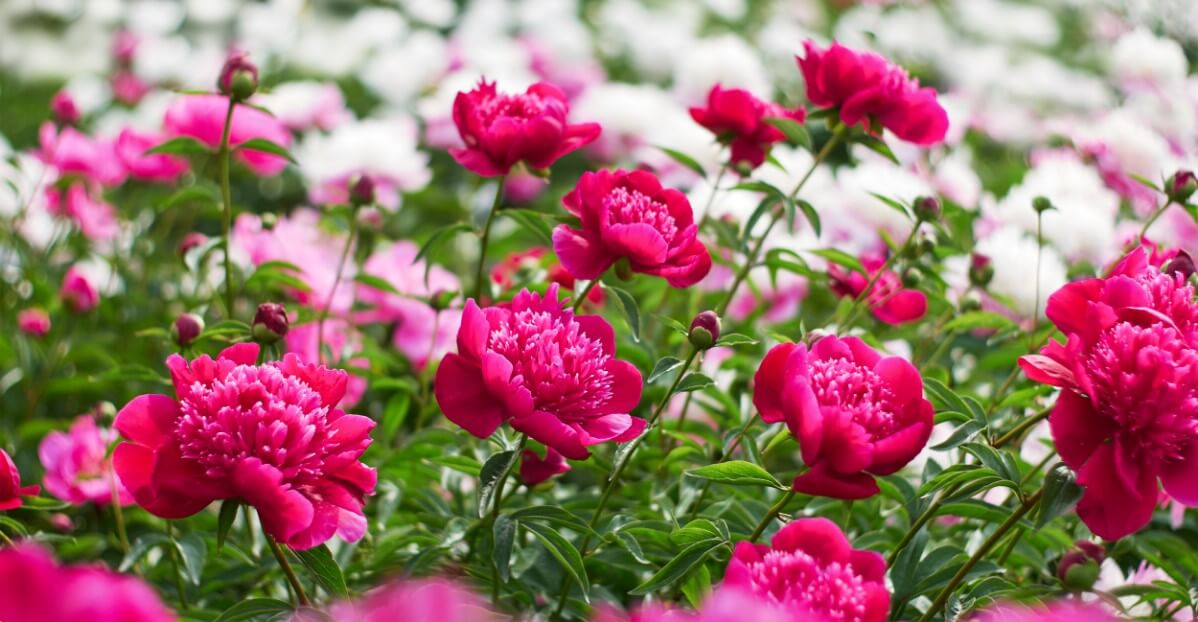
Any particular peony plant in your yard is only going to blossom for about a week, maybe a week and a half on the outside.
So, you are going to want to plant a combination of early blooming varieties, midseason blooming varieties, and late blooming varieties.
That way, even though each plant will not blossom for long, you can enjoy peonies for more than a week each year.
The American Peony Society explains, “Planting herbaceous hybrids, species and woody peonies may extend the bloom season by as much as a month, or more. Selection of specific cultivars that have different bloom seasons can provide beautiful peonies in the garden throughout spring and early summer.”
It should not be too tricky to manage up to six weeks or so of bloom time in total across your peonies. In some locations with certain cultivars, you might manage an even longer bloom period (though there could be some gaps, depending on what you plant).
Notably, if you want cut flowers that will last a long time in a vase, peonies are ideal.
Indeed, a peony flower can last around as long in a vase as it can still attached to the plant. You can expect to enjoy it for a week or even longer.
When to Plant Peonies
You should plan on planting your peonies early in autumn. In most US locations, September and October are ideal months. But if you live in zones 7-8, you can wait a little bit longer.
Try and plant your peonies in their intended permanent location. These plants do not like to be transplanted. Each time you try to relocate a peony, you are taking a risk.
The most important thing with the timing is to make sure that your peonies have at least six weeks to establish themselves before the first freeze.
What happens if you plant peonies in the springtime instead of in the fall? They will probably be okay, but they might not be ready to flower as soon as they would be if you planted them in the fall.
And you really do not want any delays in this area, because even if you plant them in autumn, it is unlikely they will bloom the first year.
Even when they do flower, the initial round of blooms may not be that dramatic. The next year, you should see more impressive blooms.
How to Plant Peonies
Ready to plant your own peonies? Let’s talk about how to do so. We will start by going over ideal growing conditions, and then we will discuss the steps.
Ideal Growing Conditions for Peonies
How Much Sun Do Peonies Need?
If you have a spot in your garden that gets full sun, that is perfect for your peonies. But peonies can also do okay with partial sun.
What Type of Soil is Right for Peonies?
Rich, fertile soil with a neutral pH is best for peonies. It should not be soggy and should drain well.
How Much Water Do Peonies Need?
While peonies are pretty low-maintenance in general, you do need to take care to ensure they are getting adequate water.
You will have to water them deeply when you plant them, and throughout the summer if your location is dry.
How to Plant Peony Tubers in Your Garden Beds
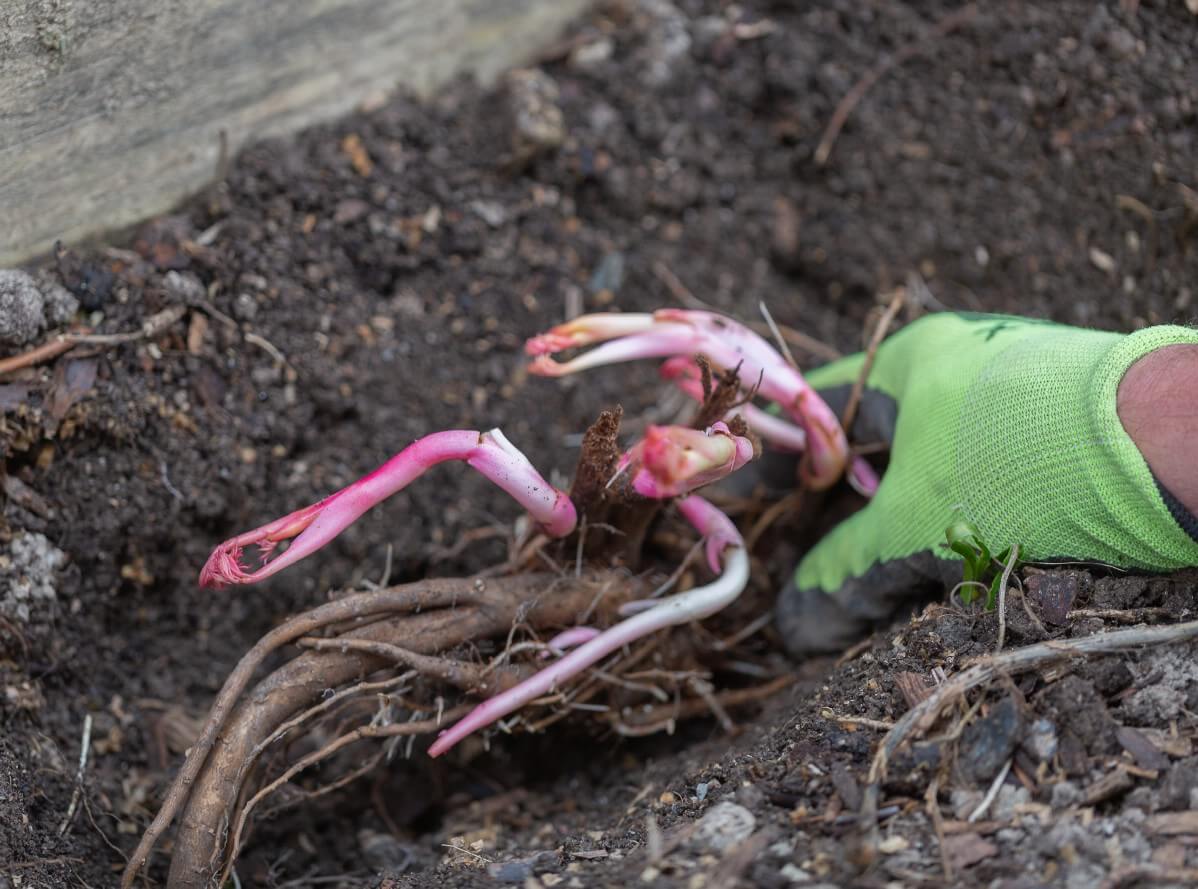
1. First, choose an appropriate spot in your garden with the right sun and soil conditions. If you are planting multiple peonies near each other, you will need to give them 3-4 feet of space. Otherwise, they may be prone to disease.
2. Dig a hole. It should be around 2 feet deep and 2 feet wide. Create a little mound of soil inside.
3. Add 1 cup of bonemeal. Consider also adding around 4 inches of compost if necessary.
4. Put the tuber down on top of the mound you created earlier. The eyes should be pointing up.
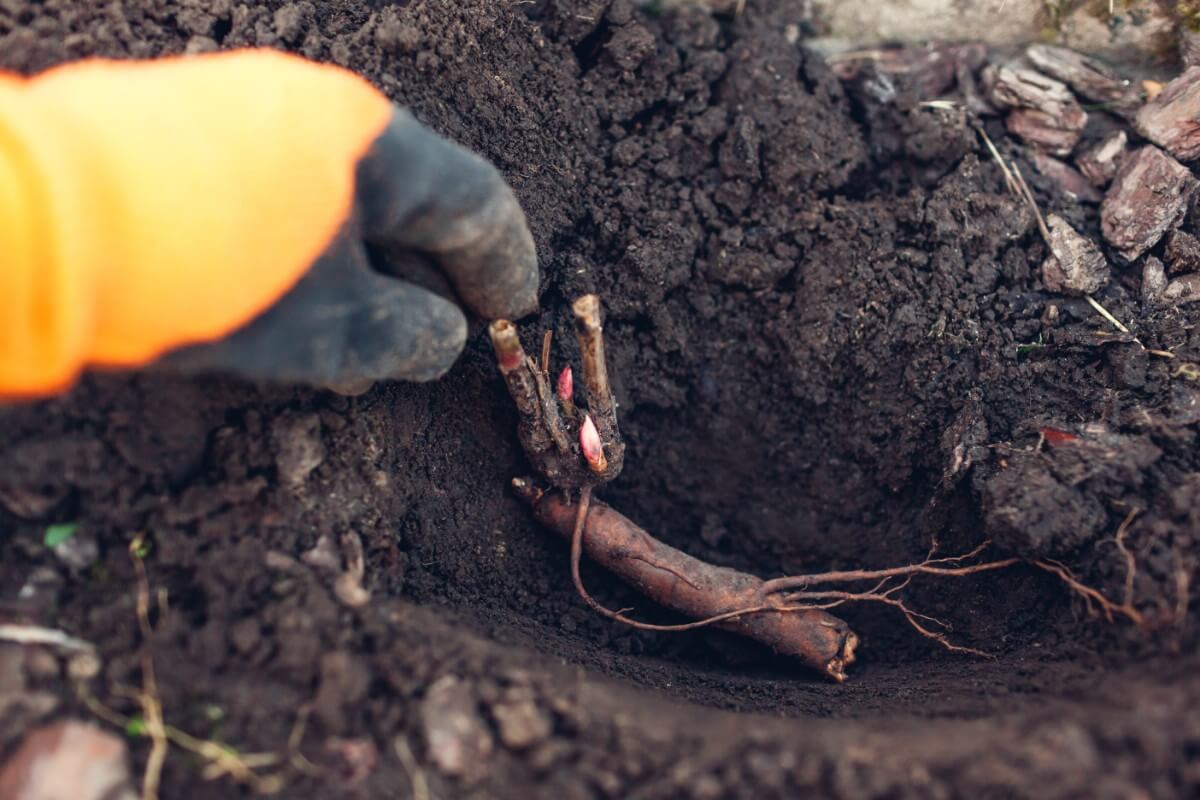
5. Fill the hole in, but ensure that the depth of the roots does not exceed 2 inches in most locations. Live in the south? Cut that depth in half. If you increase the depth beyond the specified range, your plant will likely survive, but it won’t produce flowers.
6. Gently pat down the soil.
7. Water your peony deeply.
Can You Grow Peonies in Containers?
Yes, it is possible to grow peonies in pots. As with planting peonies in your garden beds, you will need rich, well-draining soil.
Some good options include:
A mixture consisting of topsoil (65%) and perlite (35%).
A combination of peat moss and compost.
The pot itself will need to be pretty large to accommodate the peony plant. Make sure it has holes in it so the water can drain out.
How to Care for Peonies
Now you know how to plant peonies. But how do you care for them? Let’s talk about fertilizing, mulching, trimming, and more.
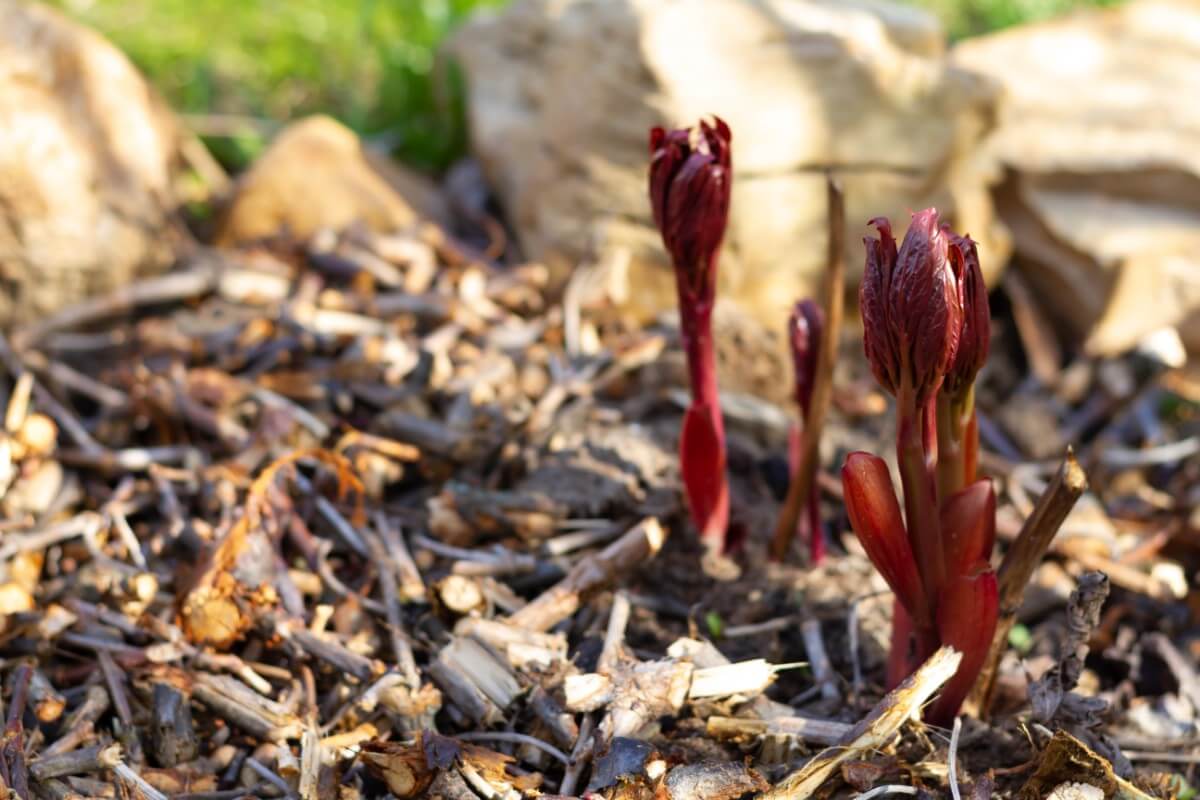
How to Fertilize Peonies
We talked about adding some bonemeal to the hole when you plant your peonies. Do you need to feed your peonies again later?
You might want to use an organic, slow-release granular fertilizer in spring. Wait until the stems measure about 1’. What type of all-purpose, organic, granular fertilizer is ideal? We have seen 5-10-10 slow release fertilizer recommended for herbaceous cultivars of peonies.
Growing tree peonies rather than herbaceous varieties? For these plants, 5-10-5 fertilizer may be a suitable option.
But whether or not you need to fertilize your peonies seems to depend on the particular types of peonies you are planting, your growing conditions, and other factors.
For example, the Peony Garden Nichols Arboretum at the University of Michigan says, “We currently do not fertilize our peony plants. However, as we remove, divide, and replant peonies, we amend the soil with compost to give them a boost since the soil has been on-site and unfertilized for nearly 95 years.”
Somewhat confusingly, the arboretum adds, “Additionally, peonies are heavy feeders and benefit from regular fertilization. A bulb fertilizer, perennial fertilizer, or 10-20-20 is a good option. Use a fertilizer low in nitrogen to prevent the peony from putting up too much dense, leafy growth and to encourage blooms. Fertilize first thing in the spring, when you see new shoots starting to come out of the ground. Spread the fertilizer around the perimeter of the plant, avoiding the crown of the peony. Applying fertilizer directly to the crown of the plant can cause damage.”
Since there seems to be some contradictory information about whether and when to fertilize peonies, we recommend that you do some additional research on the varieties you are planting to try and determine the best practices for your garden.
How to Mulch Peonies
Should you mulch peonies? It is a good idea after planting to protect the plants over the winter. Evergreen branches and straw are both suitable options. Make sure that you do not pile the mulch up against the stems. Leave a couple of inches of clearance. Otherwise, you could end up with disease problems.
How to Stake Peonies
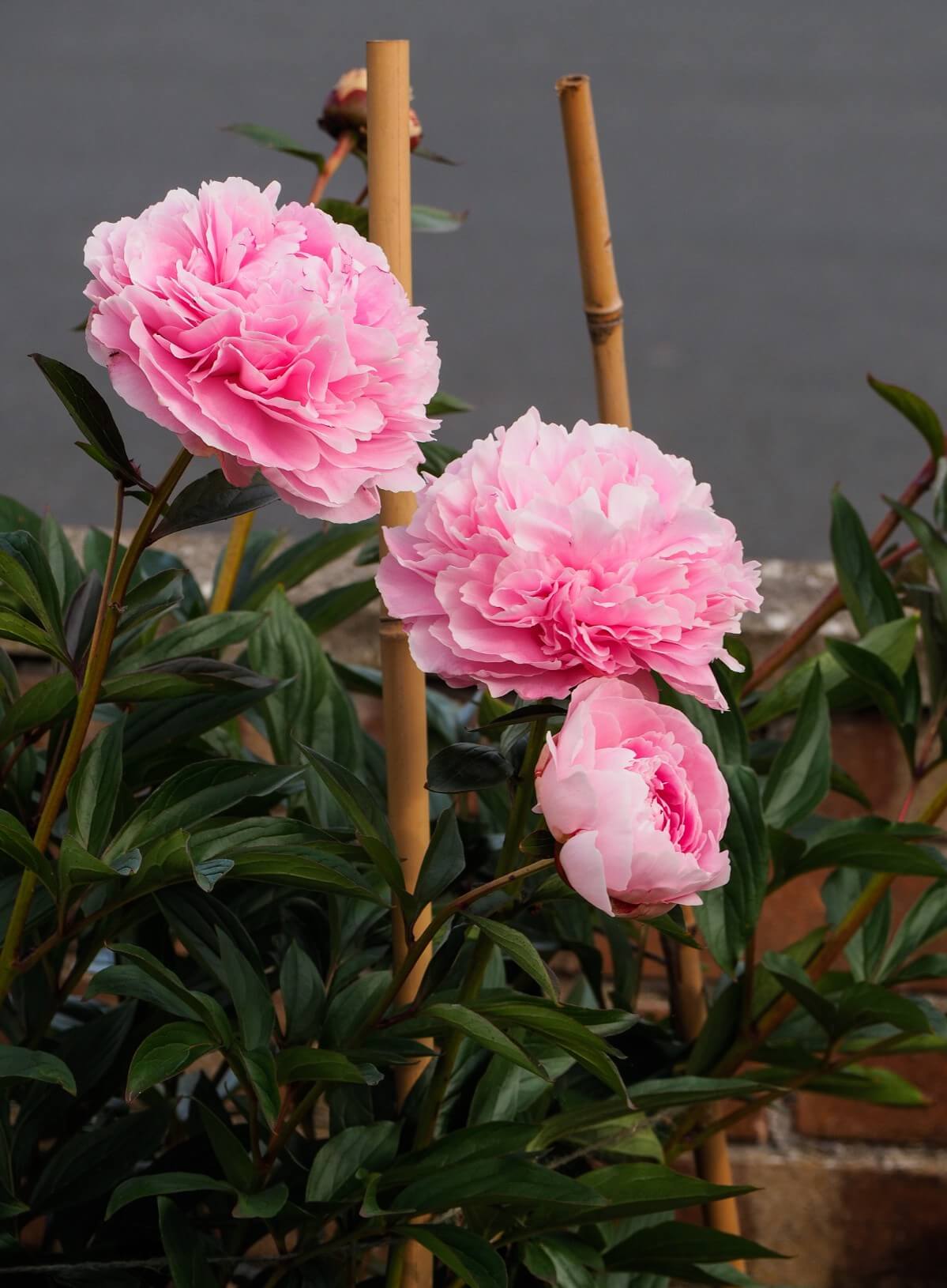
In many cases, it is not necessary to stake peonies, as the stems are sturdy enough to adequately support the weight of the blossoms. But sometimes, with particularly heavy blooms, staking can be helpful.
It may be also wise to stake peonies if your location receives a lot of strong wind or rain. Of course, if you can find a location that is sheltered from the elements in your garden, you may not need to worry about staking.
There are actually support structures you can buy that are specifically made for peonies. These are called “peony rings.”
They consist of a series of vertical stakes that are joined together with ring structures for extra support and stability.
You do not necessarily need this specialized supply, however. Regular stakes can work fine as well.
But if you do not purchase peony rings, you should still set up your stakes in a circle formation to achieve a similar effect.
How to Prune Peonies
Now, let’s talk about pruning peonies. These plants do not require a lot of work in this department, which is one of the reasons they are low-maintenance.
When to Cut Back Peonies
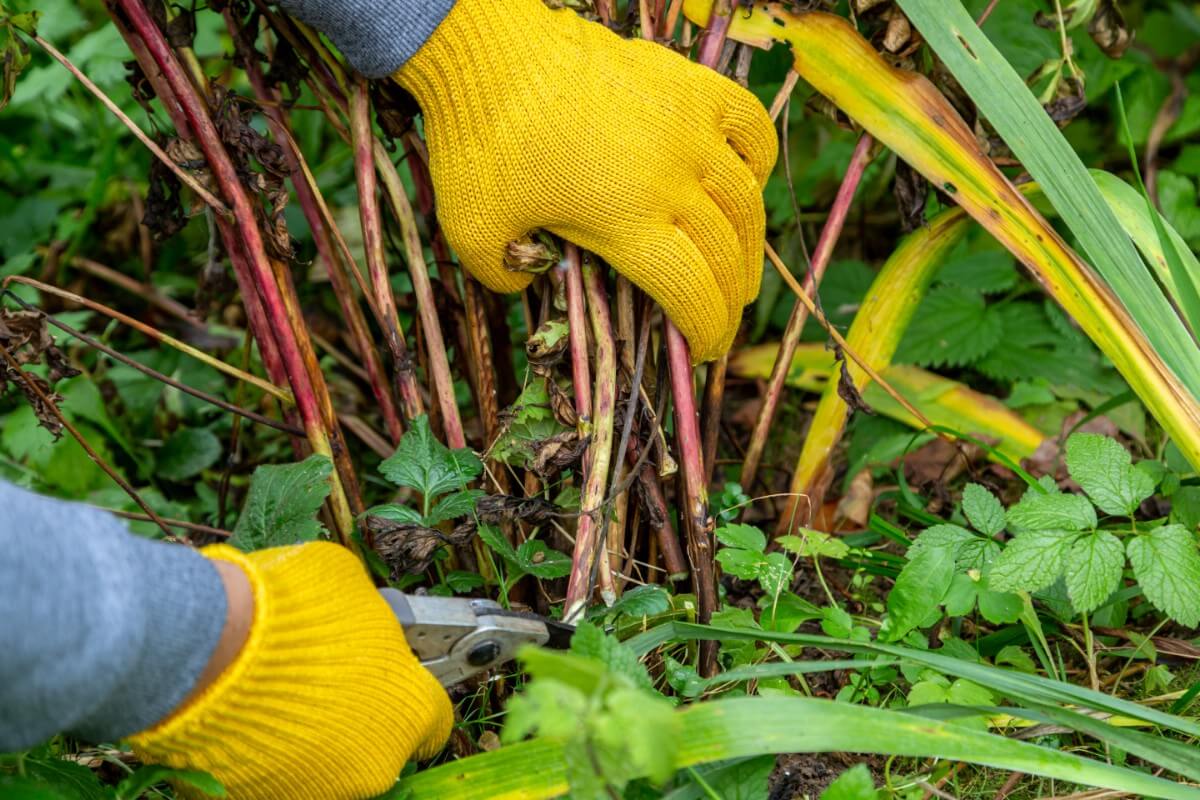
You can trim peonies back, but it is important to make sure you do not do so too early in the season.
Steve Bender at Southern Living writes some good advice on this topic. A reader wrote in asking if she could trim them after the blooms have faded for the year.
He replied, “Don't even think about trimming your peony's now! If you do, you will get no flowers next year … You see, what the leaves do all summer is soak in the sun's rays and convert that energy into food reserves for the peony. It takes a lot of reserves to produce the dozens of eye-popping blooms you've come to expect. Peony foliage needs to bask in full sun from spring until fall. Cut off that foliage beforehand and a bodacious bloomer becomes a flowerless flop.”
He continues, “Put away those pruners for now. Wait until the leaves yellow in fall. That's your sign that the peony's larder is fully stocked and it's OK to trim.”
While you should not trim your fading peonies, one thing you can do if you want is deadhead them.
Are Peonies Vulnerable to Diseases or Pests?
Steve’s last bit of advice in the article above is to make sure not to leave the cut foliage lying around the peonies, as insects and disease may become a problem if one does.
Some pests and diseases that can harm your peonies include stem rot, ringspot virus, tip blight, verticillium wilt, leaf blotch, nematodes, Japanese beetles, hoplia beetles, scale insects, peony thrips, bulb mites, and botrytis blight.
One thing you should not have a problem with is deer eating your peonies.
How to Transplant Peonies

As we discussed earlier, if you can avoid having to transplant peonies in the first place, that is ideal, because they are not easy to successfully relocate.
Just as autumn is the best time to plant peonies, it also is the best time to transplant them if you have to. The reason this is such a good time is because the plants are winding down for their dormant period during the winter.
If you are in the northern US, aim for around the middle of August. If you are in a southern state, you can shoot for the early part of November.
Is it possible to transplant peonies during other times of year? Yes, but it may not go as well. In some cases, the plants might not survive. In others, even if they make it, they may struggle to return to full health.
To remove the peony from its current site, you will need to dig around it with great care to preserve the roots and keep the rootball as intact as possible. Be careful not to tug on the stems. They are not strong enough to hold against force.
Now, you can take the peony to the new location. Before planting it, make sure you have prepped the soil if necessary. It needs to drain well, and be rich and nutritious.
As we have talked about, you should not bury the roots under more than 2 inches of soil.
It is a good idea if you can mimic the previous conditions to the best of your ability. If it was 2 inches before, make it 2 inches now. If it was 1 inch before, make it 1 inch now.
After you backfill the hole, tamp it down, and then water the plant.
Do you need to water regularly while the peony is establishing in its new location? Probably not. In fact, doing so might even cause problems, given the season. In drought conditions, however, some water might be necessary. You just need to make sure the soil is not getting soggy.
Recommended Companion Plants for Peonies
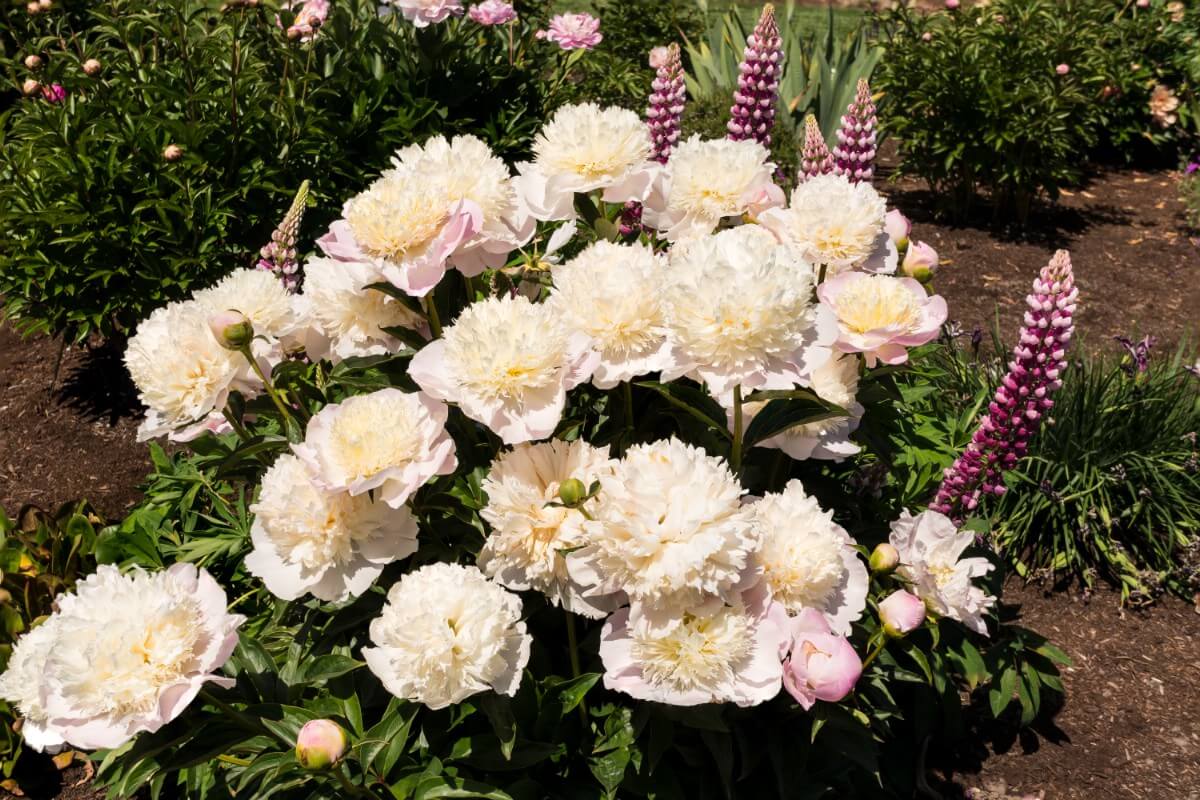
While you are planning where to plant your peonies, you should also think about companion plants. Here are a few options worth considering:
Columbines: Many people enjoy the rich contrast of colors and textures that is provided by a mixture of columbines and peonies. Plus, columbines are attractive to hummingbirds. So, this is a good way to invite some new friends to your outdoor spaces.
Roses: While peonies may put you in mind of carnations, they might also make you think of a few roses. Nonetheless, the differences between roses and peonies in terms of appearance are more than sufficient to make the two stand out from one another. So, they complement each other but also contrast with one another in a pleasing way.
Irises: Various types of irises may make good companion plants for peonies, including Siberian irises and bearded irises. A lot of people choose irises because, like peonies, they are easy to maintain.
Foxgloves: Want to bring bees to your garden? Foxgloves may draw some of your favorite buzzing garden guests, and they make a nice visual accompaniment for peonies.
Hydrangeas: If you specifically want another low-maintenance plant to grow next to your peonies, hydrangeas make a good option.
Daffodils: These sunny yellow flowers make a vibrant color contrast next to pink peonies—or a lovely complement for hybrid peonies that share their golden hues.
Camellias: If the elegance of roses appeals to you, but you are looking for something a little bit different, it is hard to go wrong with camellias as a companion plant for peonies.
Lavender: This purple flower is generally regarded as rabbit-resistant. If rabbits getting into your peonies have been giving you grief, you could try interspersing lavenders with your peony plants to see if that helps to dissuade them.
Rosemary: Rabbits also apparently do not like rosemary plants. Rosemary tastes great in cuisine, making it a useful herb to cultivate next to your peonies. It also produces beautiful periwinkle flowers.
Those are just a few ideas for peony companion plants. Anything that looks good next to peonies and which grows well in the same spot in your garden can make a great option.
Frequently Asked Questions About Growing Peonies
Peonies and carnations are very similar-looking, so you might wonder if a peony is a kind of carnation or vice versa. But they are two different plants.
Carnations have the scientific name Dianthus caryophyllus. Dianthus is the genus, and the family is Caryophyllaceae.
By contrast, the peony belongs to the Paeoniaceae family and the Paeonia genus. Peonies are larger than carnations.
But if you like the appearance of one, you will probably like the other as well.
The height of peonies depends on what specific varieties you choose to plant. For herbaceous cultivars, 2-3 feet is common, whereas the tree varieties of peonies may reach anywhere from 3-7 feet tall.
Yes. Deer should not be eating your peonies.
Even though deer do not eat peonies, rabbits, squirrels and beavers may sometimes munch on them. Hoplia beetles may eat peonies as well, as might scale insects, peony thrips, and bulb mites.
It is not uncommon to see lots of ants on peonies. While you may be concerned that they are eating your plants, they will not hurt them.
They are there to eat the nectar, but this will not cause any damage. They also may help to reduce the population of pests that do eat your peonies. So, you should generally leave them alone.
Many plants can make suitable companions for peonies. Some examples include roses, columbines, and irises.
Peonies are perennial plants. So, you can look forward to healthy peonies growing back year after year to produce gorgeous flowers.
Peonies can be considered drought-resistant, though not as much as some other perennials. Also, even though you may be able to get away with not watering peonies that often, it is better if you try to do so. They will be much healthier and will produce a more abundant display of blooms if they are well-watered.
Where to Buy Peonies
You now know all about peonies, long-living perennial plants that can reward you with lush foliage and dramatic blossoms every year.
You can shop for peonies locally, or you can buy them online. If you shop online, you will have access to the biggest selection of cultivars.
To get started growing peonies in your garden now, click the links below.
- 5000 SEEDS
- number of pieces: 50
- [54 Pcs Seeds] Mixed Peony Flower Seeds Value Bag for Planting
- [54 Pcs Seeds] Mixed Peony Flower Seeds Value Bag for Planting
- Advantages: high decoration value, decorating your garden and room.
- Drugs: perennial herbal medicines, have a healthy body.
- -Package Detail : 50 Pcs Mixed Peony Flower Seeds Value Bag for Planting
- This rare peony flower's color is gorgeous, romantic and unrestrained, according to the different color division has hundreds of varieties, the flower is big and fragrant, Since ancient times, peony...

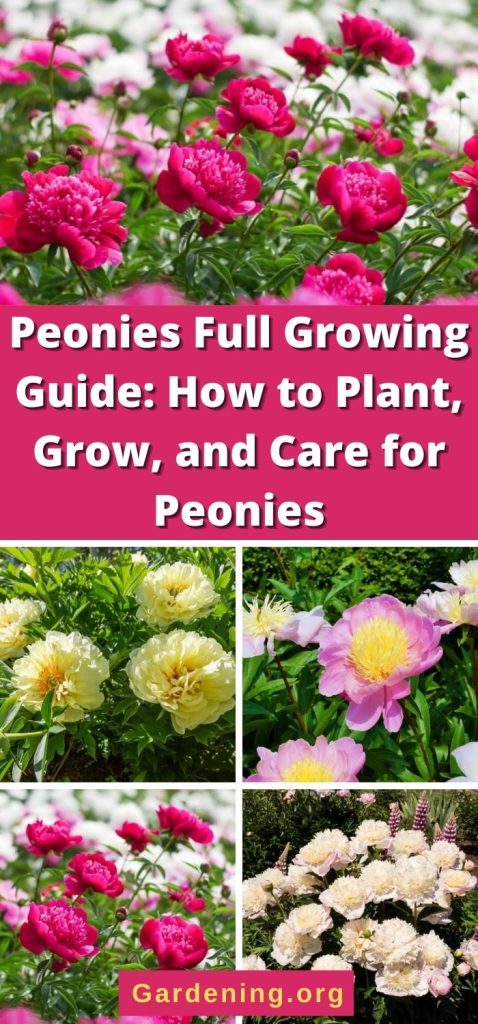
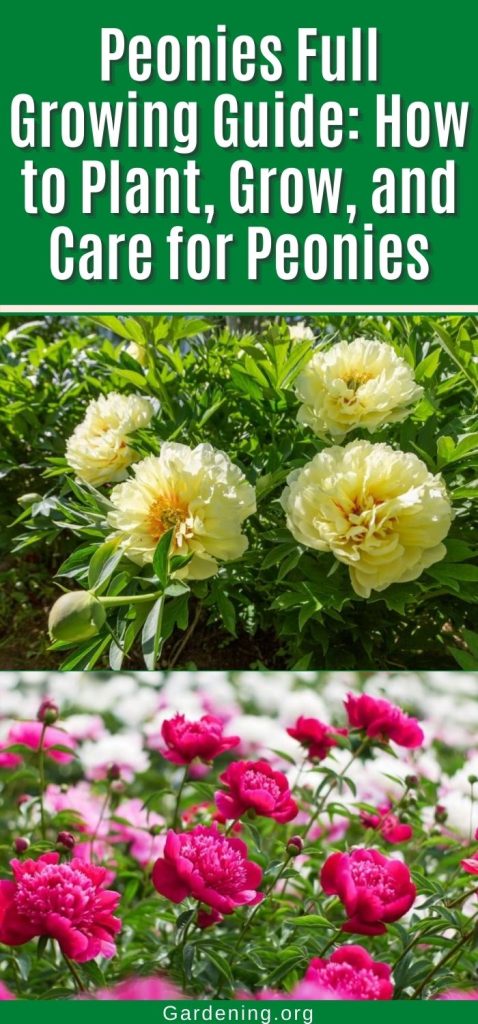
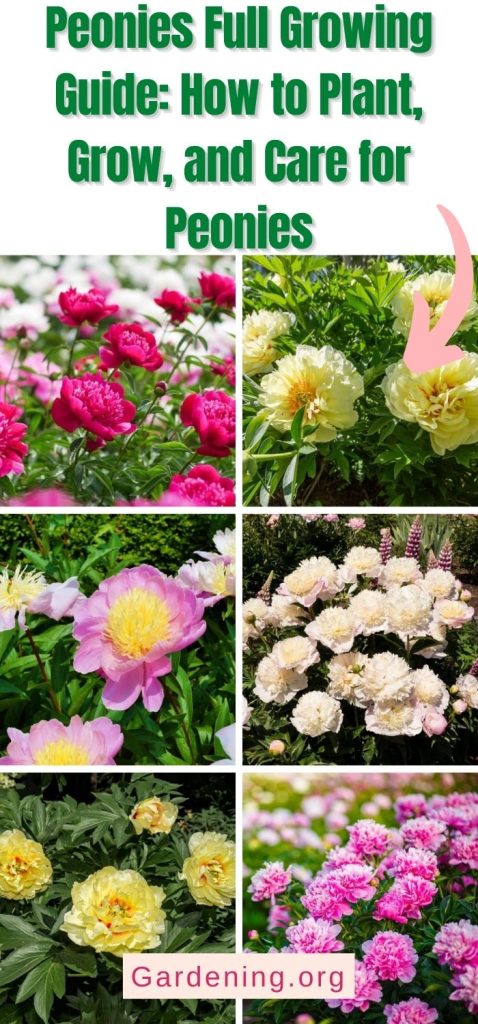
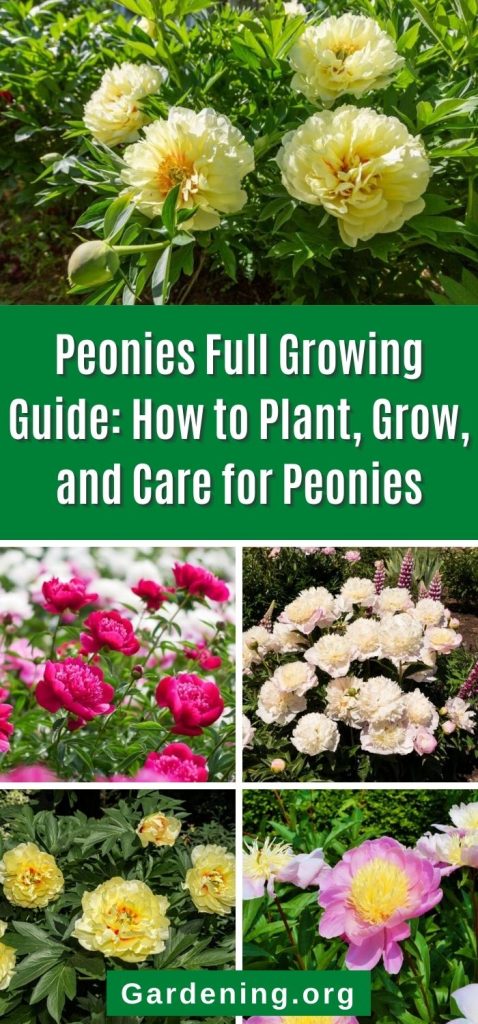

![[54 Pcs Seeds] Mixed Peony Flower Seeds Value Bag for Planting](https://m.media-amazon.com/images/I/51kIh+x9ZpL._SL160_.jpg)




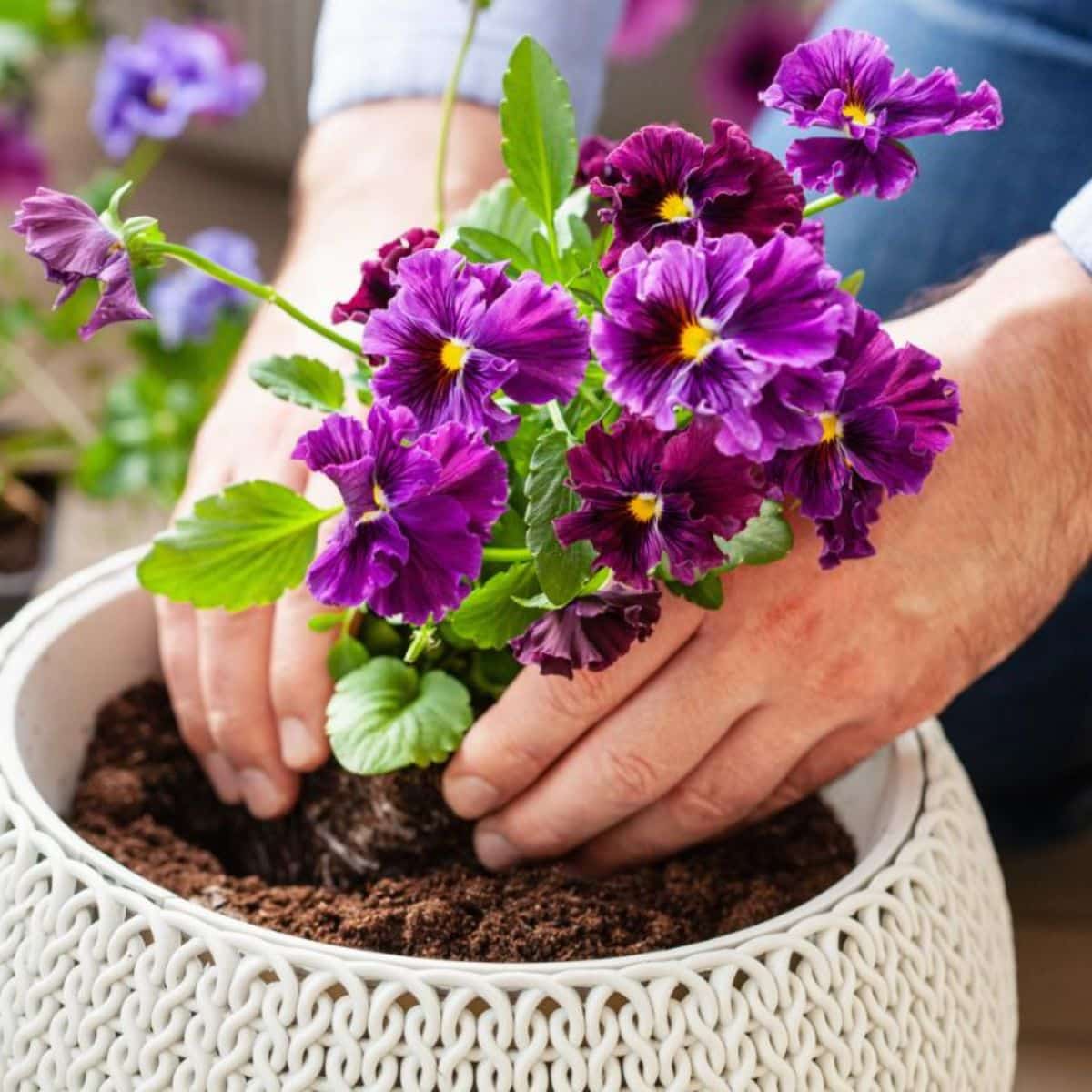
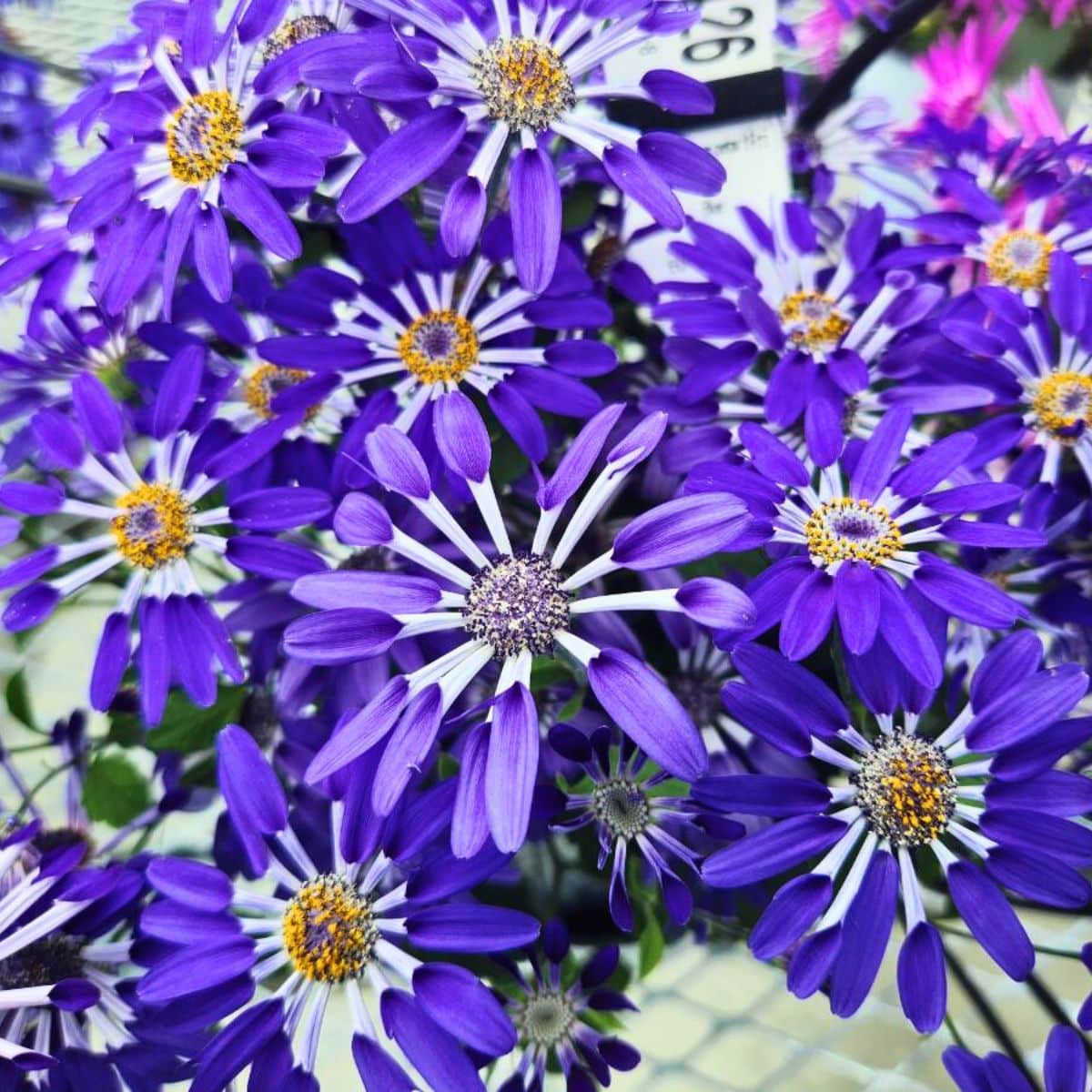
Judy
Where’s the link you mentioned in the last paragraph?
Mary Ward
Sorry it has been corrected and the links should be there now. In the box below the text.